公交车路线查询系统后台数据库设计系列文章
数据库下载 (该数据库已经输入了广州市350条公交车路线作为测试数据)
在《查询算法》 一文中已经实现了换乘算法,但是,使用存储过程InquiryT2查询从“东圃镇”到“车陂路口”的乘车路线时,发现居然用了5分钟才查找出结果,这样的 效率显然不适合实际应用。因此,有必要对原有的换乘算法进行优化和改进。在本文中,将给出一种改进的换乘算法,相比原有的算法,改进后的算法功能更强,效 率更优。
1. “压缩”RouteT0
假设RouteT0有以下几行
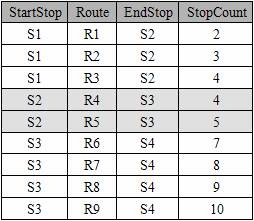
如下图所示,当查询S1到S4的二次换乘路线时,将会产生3×2×4=24个结果
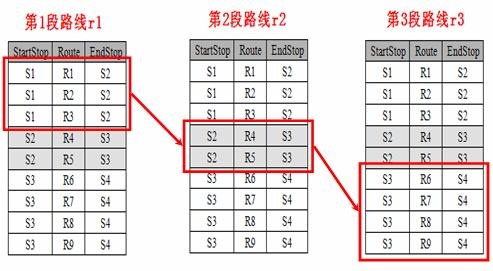
从图中可以看出,第1段路线中的3条线路的起点和站点都相同(第2、3段路线也是如此),事实上,换乘查询中关心的是两个站点之间有无线路可通,而不关心是乘坐什么路线,因此,可以将RouteT0压缩为:

如下图所示,压缩后,查询结果有原来的24条合并1组

查询结果为:

那么,为什么要对视图RouteT0进行压缩呢,原因如下:
(1)RouteT0是原有换乘算法频繁使用的视图,因此,RouteT0的数据量直接影响到查询的效率,压缩RouteT0可以减少RouteT0的数据量,加速查询效率。
(2)压缩RouteT0后,将中转站点相同的路线合并为1组,加速了对结果集排序的速度。
2.视图GRouteT0
在数据库中,将使用GRouteT0来描述压缩的RouteT0,由于本文使用的数据库的关系图与《查询算法》中有所不同,在给出GRouteT0的代码前,先说明一下:
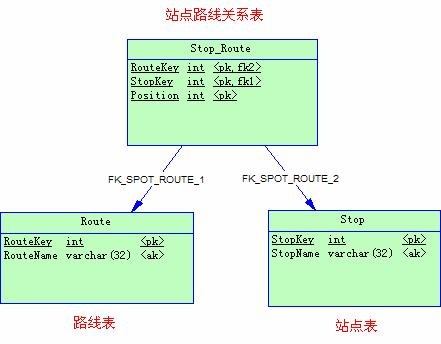
主要的改变是Stop_Route使用了整数型的RouteKey和StopKey引用Route和Stop,而不是用路线名和站点名。
GRouteT0定义如下:
create view GRouteT0
as
select
StartStopKey,
EndStopKey,
min(StopCount) as MinStopCount,
max(StopCount) as MaxStopCount
from RouteT0
group by StartStopKey,EndStopKey
注意,视图GRouteT0不仅有StartStopKey和EndStopKey列,还有MinStopCount列,MinStopCount是指从StartStop到EndStop的最短线路的站点数。例如:上述RouteT0对应的GRouteT0为:

3.二次查询算法
以下是二次换乘查询的存储过程GInquiryT2的代码,该存储过程使用了临时表来提高查询效率:

 GInquiryT2
GInquiryT2
/*
查询站点@StartStops到站点@EndStops之间的二次换乘乘车路线,多个站点用'/'分开,结果以分组方式给出,如:
exec InquiryT2 '站点1/站点2','站点3/站点4'
*/
Create proc GInquiryT2(
@StartStops varchar(2048),
@EndStops varchar(2048)
)
as
begin
declare @ss_tab table(StopKey int)
declare @es_tab table(StopKey int)
insert @ss_tab
select distinct Stop.StopKey
from dbo.SplitString(@StartStops,'/') sn,Stop
where sn.Value=Stop.StopName
insert @es_tab
select distinct Stop.StopKey
from dbo.SplitString(@EndStops,'/') sn,Stop
where sn.Value=Stop.StopName
if(exists(select top 1 * from @ss_tab sst,@es_tab est where sst.StopKey=est.StopKey))
begin
raiserror ('起点集和终点集中含有相同的站点',16,1)
return
end
declare @stops table(StopKey int)
insert @stops select StopKey from @ss_tab
insert @stops select StopKey from @es_tab
print '===================================================='
print '筛选出第1段乘车路线'
print '—————————————————-'
set statistics time on
————————————————————-
—筛选出第1段乘车路线,保存到临时表#R1中
select *
into #R1
from GRouteT0
where
StartStopKey in (select StopKey from @ss_tab)
and EndStopKey not in (Select StopKey from @stops)
order by StartStopKey,EndStopKey
—在临时表#R1上创建索引
create index index1 on #R1(StartStopKey,EndStopKey)
————————————————————-
set statistics time off
print '===================================================='
print '筛选出第3段乘车路线'
print '—————————————————-'
set statistics time on
————————————————————-
—筛选出第3段乘车路线,保存到临时表#R3中
select *
into #R3
from GRouteT0
where
EndStopKey in (select StopKey from @es_tab)
and StartStopKey not in (Select StopKey from @stops)
order by StartStopKey,EndStopKey
—在临时表上创建索引
create index index1 on #R3(StartStopKey,EndStopKey)
————————————————————-
set statistics time off
print '===================================================='
print '筛选出第2段乘车路线'
print '—————————————————-'
set statistics time on
————————————————————-
—筛选出第2段乘车路线,保存到临时表#R2中
select *
into #R2
from GRouteT0
where
StartStopKey in (select EndStopKey from #R1)
and EndStopKey in (Select StartStopKey from #R3)
—在临时表上创建索引
create clustered index index1 on #R2(StartStopKey,EndStopKey)
create index index2 on #R2(EndStopKey,StartStopKey)
————————————————————-
set statistics time off
print '===================================================='
print '二次换乘查询'
print '—————————————————-'
set statistics time on
————————————————————-
—二次换乘查询
select
ss.StopName as 起点,
dbo.JoinRoute(res.StartStopKey,res.TransStopKey1) as 路线1,
ts1.StopName as 中转站1,
dbo.JoinRoute(res.TransStopKey1,res.TransStopKey2) as 路线2,
ts2.StopName as 中转站2,
dbo.JoinRoute(res.TransStopKey2,res.EndStopKey) as 路线3,
es.StopName as 终点,
MinStopCount
from(
—查询出站点数最少的10组路线
select top 10
r1.StartStopKey as StartStopKey,
r2.StartStopKey as TransStopKey1,
r2.EndStopKey as TransStopKey2,
r3.EndStopKey as EndStopKey,
(r1.MinStopCount+r2.MinStopCount+r3.MinStopCount) as MinStopCount
from #R1 r1,#R2 r2,#R3 r3
where r1.EndStopKey=r2.StartStopKey and r2.EndStopKey=r3.StartStopKey
order by (r1.MinStopCount+r2.MinStopCount+r3.MinStopCount) asc
)res,
Stop ss,
Stop es,
Stop ts1,
Stop ts2
where
res.StartStopKey=ss.StopKey and
res.EndStopKey=es.StopKey and
res.TransStopKey1=ts1.StopKey and
res.TransStopKey2=ts2.StopKey
————————————————————-
set statistics time off
print '===================================================='
end
4.测试
(1) 测试环境
测试数据:广州市350条公交车路线
操作系统:Window XP SP2
数据库:SQL Server 2000 SP4 个人版
CPU:AMD Athlon(tm) 64 X2 Dual 2.4GHz
内存:2G
(2)选择用于测试的的站点
二次换乘查询的select语句使用的三张表#R1,#R2,#R3,因此,这三张表的数据量直接影响到二次换乘查询使用的时间:
显然,R1的数据量由起点决定,查询起始站点对应的#R1的数据量的SQL语句如下:
select Stop.StopName as '站点',count(StartStopKey) '#R1的数据量'
from RouteT0 full join Stop on RouteT0.StartStopKey=Stop.StopKey
group by Stop.StopName
order by count(StartStopKey) desc
运行结果如下:
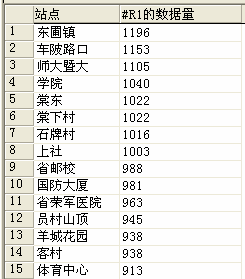
显然,但起点为“东圃镇”时,#R1的数据量最大,同理可得终点和#R3数据量关系如下:
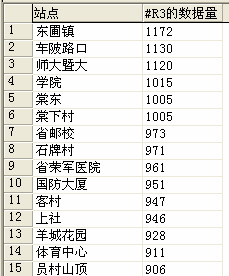
因此,在仅考虑数据量的情况下,查询“东圃镇”到“车陂路口”所用的时间是最长的。在下文中,将使用“东圃镇”作为起点,“车陂路口”为终点对二次查询算法进行效率测试
(3)效率测试
测试语句如下:
exec GInquiryT2 '东圃镇','车陂路口'
测试结果:
查询结果如下:

输出如下:

 测试输出
测试输出
====================================================
筛选出第1段乘车路线
—————————————————-
SQL Server 执行时间:
CPU 时间 = 0 毫秒,耗费时间 = 0 毫秒。
(所影响的行数为 458 行)
SQL Server 执行时间:
CPU 时间 = 10 毫秒,耗费时间 = 10 毫秒。
SQL Server 分析和编译时间:
CPU 时间 = 0 毫秒,耗费时间 = 0 毫秒。
SQL Server 执行时间:
CPU 时间 = 0 毫秒,耗费时间 = 0 毫秒。
SQL Server 执行时间:
CPU 时间 = 0 毫秒,耗费时间 = 0 毫秒。
====================================================
筛选出第3段乘车路线
—————————————————-
SQL Server 执行时间:
CPU 时间 = 0 毫秒,耗费时间 = 0 毫秒。
(所影响的行数为 449 行)
SQL Server 执行时间:
CPU 时间 = 0 毫秒,耗费时间 = 9 毫秒。
SQL Server 分析和编译时间:
CPU 时间 = 0 毫秒,耗费时间 = 0 毫秒。
SQL Server 执行时间:
CPU 时间 = 1 毫秒,耗费时间 = 1 毫秒。
SQL Server 执行时间:
CPU 时间 = 15 毫秒,耗费时间 = 1 毫秒。
====================================================
筛选出第2段乘车路线
—————————————————-
SQL Server 执行时间:
CPU 时间 = 0 毫秒,耗费时间 = 0 毫秒。
(所影响的行数为 41644 行)
SQL Server 执行时间:
CPU 时间 = 825 毫秒,耗费时间 = 825 毫秒。
SQL Server 分析和编译时间:
CPU 时间 = 0 毫秒,耗费时间 = 0 毫秒。
SQL Server 执行时间:
CPU 时间 = 93 毫秒,耗费时间 = 98 毫秒。
SQL Server 执行时间:
CPU 时间 = 93 毫秒,耗费时间 = 98 毫秒。
SQL Server 分析和编译时间:
CPU 时间 = 0 毫秒,耗费时间 = 1 毫秒。
SQL Server 执行时间:
CPU 时间 = 73 毫秒,耗费时间 = 73 毫秒。
SQL Server 执行时间:
CPU 时间 = 79 毫秒,耗费时间 = 73 毫秒。
====================================================
二次换乘查询
—————————————————-
SQL Server 执行时间:
CPU 时间 = 0 毫秒,耗费时间 = 0 毫秒。
(所影响的行数为 10 行)
SQL Server 执行时间:
CPU 时间 = 140 毫秒,耗费时间 = 141 毫秒。
从消息窗口的信息可以看出,查询大概用了1秒
5.效率优化
用GInquiryT2查询“东圃镇”到“车陂路口”仅用了1秒钟,那么,还能不能再优化呢?仔细分析输出的结果,可发现查询时最耗时的并不是换乘查询语句(140ms),而是筛选出第2段查询路线的语句(825ms),如图所示:
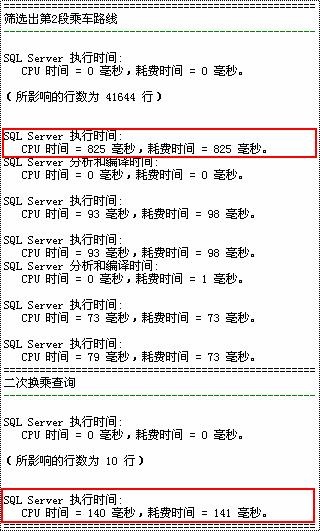
那么有没有方法可以提高筛选第2段路线的效率呢?答案是肯定的。只需把GRouteT0改成实表,并创建索引就行了。修改成实表后,就不需要把第2段路线缓存到临时表#R2中,修改后的GInquiryT2(重命名为GInquiryT2_1)如下:

 GInquiryT2_1
GInquiryT2_1
/*
查询站点@StartStops到站点@EndStops之间的二次换乘乘车路线,多个站点用'/'分开,结果以分组方式给出,如:
exec GInquiryT2_1 '站点1/站点2','站点3/站点4'
*/
Create proc GInquiryT2_1(
@StartStops varchar(2048),
@EndStops varchar(2048)
)
as
begin
declare @ss_tab table(StopKey int)
declare @es_tab table(StopKey int)
insert @ss_tab
select distinct Stop.StopKey
from dbo.SplitString(@StartStops,'/') sn,Stop
where sn.Value=Stop.StopName
insert @es_tab
select distinct Stop.StopKey
from dbo.SplitString(@EndStops,'/') sn,Stop
where sn.Value=Stop.StopName
if(exists(select top 1 * from @ss_tab sst,@es_tab est where sst.StopKey=est.StopKey))
begin
raiserror ('起点集和终点集中含有相同的站点',16,1)
return
end
declare @stops table(StopKey int)
insert @stops select StopKey from @ss_tab
insert @stops select StopKey from @es_tab
print '===================================================='
print '筛选出第1段乘车路线'
print '—————————————————-'
set statistics time on
————————————————————-
—筛选出第1段乘车路线,保存到临时表#R1中
select *
into #R1
from GRouteT0
where
StartStopKey in (select StopKey from @ss_tab)
and EndStopKey not in (Select StopKey from @stops)
order by StartStopKey,EndStopKey
—在临时表#R1上创建索引
create index index1 on #R1(StartStopKey,EndStopKey)
————————————————————-
set statistics time off
print '===================================================='
print '筛选出第3段乘车路线'
print '—————————————————-'
set statistics time on
————————————————————-
—筛选出第3段乘车路线,保存到临时表#R3中
select *
into #R3
from GRouteT0
where
EndStopKey in (select StopKey from @es_tab)
and StartStopKey not in (Select StopKey from @stops)
order by StartStopKey,EndStopKey
—在临时表上创建索引
create index index1 on #R3(StartStopKey,EndStopKey)
————————————————————-
set statistics time off
print '===================================================='
print '二次换乘查询'
print '—————————————————-'
set statistics time on
————————————————————-
—二次换乘查询
select
ss.StopName as 起点,
dbo.JoinRoute(res.StartStopKey,res.TransStopKey1) as 路线1,
ts1.StopName as 中转站1,
dbo.JoinRoute(res.TransStopKey1,res.TransStopKey2) as 路线2,
ts2.StopName as 中转站2,
dbo.JoinRoute(res.TransStopKey2,res.EndStopKey) as 路线3,
es.StopName as 终点,
MinStopCount
from(
—查询出站点数最少的10组路线
select top 10
r1.StartStopKey as StartStopKey,
r2.StartStopKey as TransStopKey1,
r2.EndStopKey as TransStopKey2,
r3.EndStopKey as EndStopKey,
(r1.MinStopCount+r2.MinStopCount+r3.MinStopCount) as MinStopCount
from #R1 r1,GRouteT0 r2,#R3 r3
where r1.EndStopKey=r2.StartStopKey and r2.EndStopKey=r3.StartStopKey
order by (r1.MinStopCount+r2.MinStopCount+r3.MinStopCount) asc
)res,
Stop ss,
Stop es,
Stop ts1,
Stop ts2
where
res.StartStopKey=ss.StopKey and
res.EndStopKey=es.StopKey and
res.TransStopKey1=ts1.StopKey and
res.TransStopKey2=ts2.StopKey
————————————————————-
set statistics time off
print '===================================================='
end
下面,仍然用查询“东圃镇”到“车陂路口”为例测试改成实表后GInquiryT2的效率,测试语句如下:
exec GInquiryT2_1 '东圃镇','车陂路口'
消息窗口输出如下:

 测试输出
测试输出
====================================================
筛选出第1段乘车路线
—————————————————-
SQL Server 执行时间:
CPU 时间 = 0 毫秒,耗费时间 = 0 毫秒。
(所影响的行数为 458 行)
SQL Server 执行时间:
CPU 时间 = 0 毫秒,耗费时间 = 3 毫秒。
SQL Server 分析和编译时间:
CPU 时间 = 0 毫秒,耗费时间 = 0 毫秒。
SQL Server 执行时间:
CPU 时间 = 0 毫秒,耗费时间 = 0 毫秒。
SQL Server 执行时间:
CPU 时间 = 0 毫秒,耗费时间 = 0 毫秒。
====================================================
筛选出第3段乘车路线
—————————————————-
SQL Server 执行时间:
CPU 时间 = 0 毫秒,耗费时间 = 0 毫秒。
(所影响的行数为 449 行)
SQL Server 执行时间:
CPU 时间 = 6 毫秒,耗费时间 = 6 毫秒。
SQL Server 分析和编译时间:
CPU 时间 = 0 毫秒,耗费时间 = 0 毫秒。
SQL Server 执行时间:
CPU 时间 = 0 毫秒,耗费时间 = 1 毫秒。
SQL Server 执行时间:
CPU 时间 = 0 毫秒,耗费时间 = 1 毫秒。
====================================================
二次换乘查询
—————————————————-
SQL Server 执行时间:
CPU 时间 = 0 毫秒,耗费时间 = 0 毫秒。
(所影响的行数为 10 行)
SQL Server 执行时间:
CPU 时间 = 250 毫秒,耗费时间 = 253 毫秒。
====================================================
从输出可以看出,大概用了250ms
6.展开路线组
GInquiryT2查询给出的结果是10组最短路线,那么,怎样才能得到最短的10条路线,显然,只需将这10组路线展开即可(展开后的路线 数>=10),而最短的10条路线必然在展开的结果中。查询10条最短路线的存储过程GInquiryT2_Expand如下:

 GInquiryT2_Expand
GInquiryT2_Expand
Create proc GInquiryT2_Expand(
@StartStops varchar(2048),
@EndStops varchar(2048)
)
as
begin
declare @ss_tab table(StopKey int)
declare @es_tab table(StopKey int)
insert @ss_tab
select distinct Stop.StopKey
from dbo.SplitString(@StartStops,'/') sn,Stop
where sn.Value=Stop.StopName
insert @es_tab
select distinct Stop.StopKey
from dbo.SplitString(@EndStops,'/') sn,Stop
where sn.Value=Stop.StopName
if(exists(select top 1 * from @ss_tab sst,@es_tab est where sst.StopKey=est.StopKey))
begin
raiserror ('起点集和终点集中含有相同的站点',16,1)
return
end
declare @stops table(StopKey int)
insert @stops select StopKey from @ss_tab
insert @stops select StopKey from @es_tab
print '===================================================='
print '筛选出第1段乘车路线'
print '—————————————————-'
set statistics time on
————————————————————-
—筛选出第1段乘车路线,保存到临时表#R1中
select *
into #R1
from GRouteT0
where
StartStopKey in (select StopKey from @ss_tab)
and EndStopKey not in (Select StopKey from @stops)
order by StartStopKey,EndStopKey
—在临时表#R1上创建索引
create index index1 on #R1(StartStopKey,EndStopKey)
————————————————————-
set statistics time off
print '===================================================='
print '筛选出第3段乘车路线'
print '—————————————————-'
set statistics time on
————————————————————-
—筛选出第3段乘车路线,保存到临时表#R3中
select *
into #R3
from GRouteT0
where
EndStopKey in (select StopKey from @es_tab)
and StartStopKey not in (Select StopKey from @stops)
order by StartStopKey,EndStopKey
—在临时表上创建索引
create index index1 on #R3(StartStopKey,EndStopKey)
————————————————————-
set statistics time off
print '===================================================='
print '二次换乘查询'
print '—————————————————-'
set statistics time on
————————————————————-
—二次换乘查询
select
ss.StopName as 起点,
r1.RouteName as '路线 1',
ts1.StopName as 中转站1,
r2.RouteName as '路线 2',
ts2.StopName as 中转站2,
r3.RouteName as '路线 3',
es.StopName as 终点,
res.StopCount as 总站点数
from(
—展开最优 10 组路线 得到最短 10 条路线
select top 10
res.StartStopKey as StartStopKey,
rt1.RouteKey as RouteKey_SS_TS1,
res.TransStopKey1 as TransStopKey1,
rt2.RouteKey as RouteKey_TS1_TS2,
res.TransStopKey2 as TransStopKey2,
rt3.RouteKey as RouteKey_TS2_ES,
res.EndStopKey as EndStopkey,
(rt1.StopCount+rt2.StopCount+rt3.StopCount) as StopCount
from(
—查询出站点数最少的 10 组路线
select top 10
r1.StartStopKey as StartStopKey,
r2.StartStopKey as TransStopKey1,
r2.EndStopKey as TransStopKey2,
r3.EndStopKey as EndStopKey,
(r1.MinStopCount+r2.MinStopCount+r3.MinStopCount) as MinStopCount
from #R1 r1,GRouteT0 r2,#R3 r3
where r1.EndStopKey=r2.StartStopKey and r2.EndStopKey=r3.StartStopKey
order by (r1.MinStopCount+r2.MinStopCount+r3.MinStopCount) asc
)res,
RouteT0 rt1,
RouteT0 rt2,
RouteT0 rt3
where
rt1.StartStopKey=res.StartStopKey and rt1.EndStopKey=res.TransStopKey1 and
rt2.StartStopKey=res.TransStopKey1 and rt2.EndStopKey=res.TransStopKey2 and
rt3.StartStopKey=res.TransStopKey2 and rt3.EndStopKey=res.EndStopKey
order by (rt1.StopCount+rt2.StopCount+rt3.StopCount) asc
)res
left join Stop ss on res.StartStopKey=ss.StopKey
left join Stop es on res.EndStopKey=es.StopKey
left join Stop ts1 on res.TransStopKey1=ts1.StopKey
left join Stop ts2 on res.TransStopKey2=ts2.StopKey
left join Route r1 on res.RouteKey_SS_TS1=r1.RouteKey
left join Route r2 on res.RouteKey_TS1_TS2=r2.RouteKey
left join Route r3 on res.RouteKey_TS2_ES=r3.RouteKey
————————————————————-
set statistics time off
print '===================================================='
end下面,仍然以查询“东圃镇”到“车陂路口”为例测试GInquiryT2_Expand,代码如下:
exec GInquiryT2_Expand '东圃镇','车陂路口'
查询结果如下:
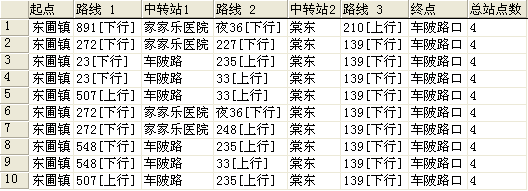
消息窗口输出如下:

 测试输出
测试输出
====================================================
筛选出第1段乘车路线
—————————————————-
SQL Server 执行时间:
CPU 时间 = 0 毫秒,耗费时间 = 0 毫秒。
(所影响的行数为 458 行)
SQL Server 执行时间:
CPU 时间 = 0 毫秒,耗费时间 = 3 毫秒。
SQL Server 分析和编译时间:
CPU 时间 = 0 毫秒,耗费时间 = 0 毫秒。
SQL Server 执行时间:
CPU 时间 = 0 毫秒,耗费时间 = 0 毫秒。
SQL Server 执行时间:
CPU 时间 = 0 毫秒,耗费时间 = 1 毫秒。
====================================================
筛选出第3段乘车路线
—————————————————-
SQL Server 执行时间:
CPU 时间 = 0 毫秒,耗费时间 = 0 毫秒。
(所影响的行数为 449 行)
SQL Server 执行时间:
CPU 时间 = 6 毫秒,耗费时间 = 6 毫秒。
SQL Server 分析和编译时间:
CPU 时间 = 0 毫秒,耗费时间 = 0 毫秒。
SQL Server 执行时间:
CPU 时间 = 0 毫秒,耗费时间 = 1 毫秒。
SQL Server 执行时间:
CPU 时间 = 0 毫秒,耗费时间 = 1 毫秒。
====================================================
二次换乘查询
—————————————————-
SQL Server 执行时间:
CPU 时间 = 0 毫秒,耗费时间 = 0 毫秒。
(所影响的行数为 10 行)
SQL Server 执行时间:
CPU 时间 = 282 毫秒,耗费时间 = 301 毫秒。
====================================================
由输出结果可看出,大约用了300ms
7.总结
下面,对本文使用的优化策略做一下总结:
(1)使用临时表;
(2)将频繁使用的视图改为表;
(3)从实际出发,合并RouteT0中类似的行,从而“压缩”RouteT0的数据量,减少查询生成的结果,提高查询和排序效率。
作者:
转载:http://www.cnblogs.com/lucc/archive/2009/03/03/1401863.html









 Mikel
Mikel



